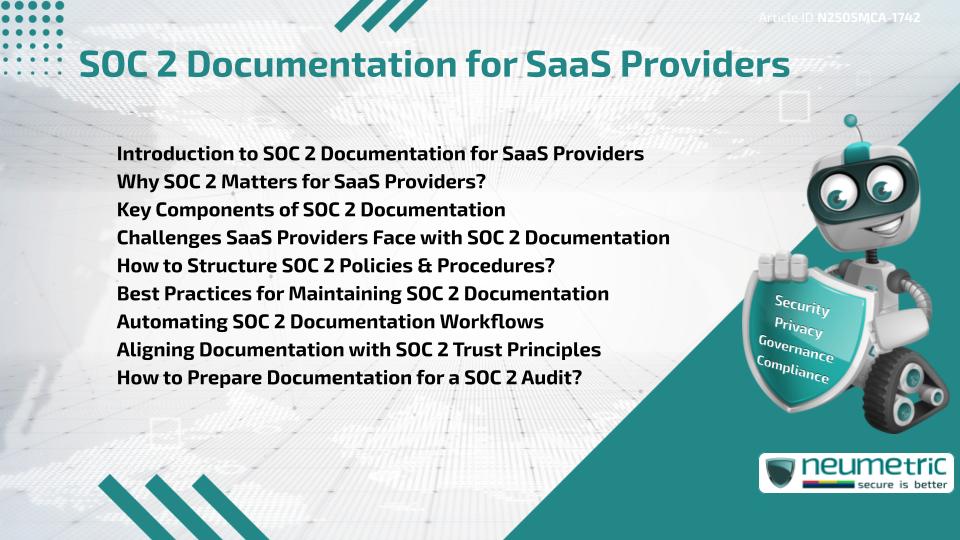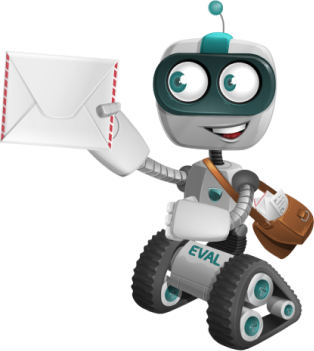Table of Contents
ToggleIntroduction to SOC 2 Documentation for SaaS Providers
In the cloud-first world, Software as a Service [SaaS] providers face increasing pressure to prove the security & integrity of their platforms. One way to build trust with customers & Stakeholders is through SOC 2 Compliance. However, meeting the requirements of SOC 2 goes beyond technical security—it depends heavily on well-maintained documentation.
This article breaks down what SOC 2 documentation for SaaS Providers entails, why it matters & how to approach it effectively without becoming overwhelmed. Whether you are preparing for your first Audit or streamlining your current practices, this guide will help you navigate the documentation landscape with clarity & confidence.
Why SOC 2 Matters for SaaS Providers?
SOC 2 is a Framework developed by the American Institute of Certified Public Accountants [AICPA] that assesses a service provider’s controls related to security, availability, processing integrity, confidentiality & Privacy.
For SaaS Providers, achieving SOC 2 Compliance is often a key requirement for working with enterprise clients. SOC 2 documentation for SaaS Providers serves as written proof of your internal controls, Risk Management practices & system monitoring processes. Without proper documentation, it becomes difficult to demonstrate Compliance or respond effectively during an Audit.
Learn more about why SOC 2 matters for service organisations.
Key Components of SOC 2 Documentation
SOC 2 documentation for SaaS Providers typically includes:
- Policies: These are the official rules that guide your organisation’s security posture, such as data Access Control or encryption Policies.
- Procedures: Step-by-step instructions describing how your Policies are implemented.
- System Descriptions: Detailed overviews of your infrastructure, applications & data flow.
- Risk Assessments: Periodic reviews identifying & addressing Risks.
- Change Management Logs: Records of software updates, infrastructure changes & system upgrades.
Each component must clearly demonstrate how your operational practices support the requirements outlined in the SOC 2 Trust Services Criteria. They are not just checkboxes, but integral to business transparency.
Challenges SaaS Providers Face with SOC 2 Documentation
Many SaaS Providers struggle with documentation due to limited internal resources or unclear guidelines. Common issues include:
- Over-documentation: Documenting every small task can overwhelm the process & make it harder to maintain focus & clarity.
- Outdated records: If documentation isn’t kept current, it may no longer represent the actual day-to-day operations.
- Misalignment with controls: Documentation should support & map to implemented controls, not contradict them.
One practical approach is to use a central repository where all SOC 2 documentation for SaaS Providers is version-controlled & regularly reviewed.
How to Structure SOC 2 Policies & Procedures?
A well-organized & consistent structure supports both internal teams & external auditors in understanding your processes. Each document should follow a consistent format:
- Title & Purpose
- Scope & Applicability
- Responsibilities
- Procedures or Control Steps
- Review Frequency
Avoid generic language. Customise each document to accurately represent your real-world systems & operational processes. If you use Third Party services, mention them explicitly in your controls.
Best Practices for maintaining SOC 2 Documentation
SOC 2 documentation is not a one-time task—it must evolve with your business. To stay on top of it:
- Review Policies quarterly or after major infrastructure or personnel changes.
- Designate a responsible team or person to manage & maintain each document.
- Use version control to track updates & access logs.
SOC 2 documentation for SaaS Providers should always reflect current practices. If your policy states that logs are retained for ninety (90) days, then your actual retention system must match.
Check this GRC process reference for tips on integrating Governance practices.
Automating SOC 2 Documentation Workflows
Manual documentation is error-prone & time-consuming. Modern SaaS businesses benefit from automating their Compliance workflows through tools that:
- Monitor control effectiveness
- Auto-generate reports & logs
- Send reminders for policy reviews
Automation helps reduce human error & ensures that your SOC 2 documentation for SaaS Providers remains current & Audit-ready.
Explore this guide to automating SOC 2 workflows.
Aligning Documentation with SOC 2 Trust Principles
Each Trust Services Criterion—Security, Availability, Processing Integrity, Confidentiality & Privacy—requires specific documentation:
- Security: Firewalls, Access Control & Incident Response Policies
- Availability: Business Continuity & Disaster Recovery plans
- Processing Integrity: Data validation & error-handling processes
- Confidentiality: Encryption Policies & NDA agreements
- Privacy: User consent handling & data minimisation
SOC 2 documentation for SaaS Providers must align with the controls outlined under each principle. This alignment ensures a smoother Audit & a more resilient organisation.
How to Prepare Documentation for a SOC 2 Audit?
Prior to the Audit, conduct an internal review of all documentation.
Check for:
- Missing or outdated files
- Mismatches between written procedures & how they are carried out in practice.
- Accessibility for auditors
Create a folder structure that mirrors SOC 2 criteria, & include links or references to supporting evidence such as logs, screenshots or Third Party attestations.
Conclusion
Strong SOC 2 documentation is foundational for SaaS Providers that aim to scale securely & build Client trust. It provides a clear picture of your organisation’s internal controls & demonstrates your readiness for scrutiny. Good documentation does more than pass audits—it embeds security into the very fabric of your operations.
Takeaways
- SOC 2 documentation plays a fundamental role in ensuring Compliance for SaaS Providers.
- It includes Policies, procedures, logs & system overviews.
- inadequate documentation can slow down the Audit or cause it to go off track.
- Clear structure & regular updates are essential.
- Automation & alignment with Trust Principles simplify maintenance.
FAQ
What documents are required for SOC 2 Compliance?
SOC 2 documentation for SaaS Providers typically includes Policies, procedures, Risk Assessments, system descriptions & access logs.
How often should SOC 2 documentation be updated?
Documentation should be reviewed at least quarterly or after any major system, team or policy change to ensure accuracy.
Can templates be used for SOC 2 documentation?
Yes, templates are useful starting points but must be tailored to your environment to reflect actual practices & controls.
Is automation recommended for managing SOC 2 documentation?
Yes, automation helps streamline document updates, control monitoring & Audit preparation, making the process more efficient.
How does documentation support a SOC 2 Audit?
Auditors review documentation to verify that controls are not only designed but also implemented & operating effectively.
What tools can help with SOC 2 documentation?
Governance platforms & Compliance automation tools are commonly used by SaaS Providers to streamline documentation, monitor controls & simplify audits.
Are Policies alone enough for SOC 2 Compliance?
No, Policies must be supported by actionable procedures & evidence that they are being followed in daily operations.
What happens if my documentation is incomplete during the Audit?
Incomplete documentation can result in a qualified or failed report, which may affect your ability to serve certain customers.


